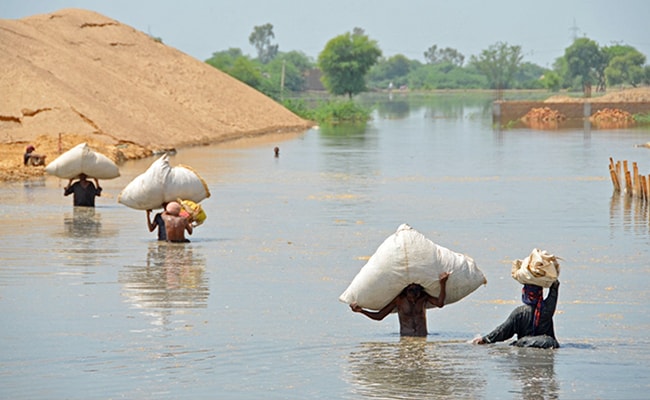“Food prices are likely to drive headline inflation upwards even further over the coming months. That could prompt the central bank to tighten monetary policy even more aggressively to anchor inflation expectations.”
By Staff Reporter
ISLAMABAD: Pakistan’s already weak economy will further drag on growth in the current fiscal year of 2022/23 as it confronted catastrophic floods that wiped out vital cash crops in two provinces and would also exacerbate political instability, Fitch Solutions said.
A harsh monsoon season and melting glaciers have caused rainfall in Pakistan to come in at 44.3 percent above normal, and the country has been grappling with floods and mudslides since June. At least 33 million people across the country have been impacted, with close to 1,500 people killed since June 14, and the authorities have declared at least 72 districts (out of 160) as calamity-stricken. In addition, almost 720,000 livestock have been killed in the flooding while 3,500km of roads and 150 bridges have also been damaged.
“The conditions will remain challenging in the near term as rains are set to continue, falling on already-sodden land, further increasing the likelihood of flash floods and landslides,” the global rating agency said in its latest report on Pakistan.
Fitch said it expects the number of citizens facing food insecurity to rise further due to floods, posing additional downside risks to social stability. “Already, Pakistan faces a volatile political landscape, which is reflected in our proprietary Short-Term Political Risk Index (STPRI) score, which comes in at 39.2 out of 100, well below the global average score of 61.0.”
The incumbent ruling coalition, led by Prime Minister Shahbaz Sharif from the Pakistan Muslim League-Nawaz (PML-N), has struggled to boost its public approval rating since coming into power in April due to the rising cost of living and the floods will make things worse.
“Downside risks to social stability are already elevated in Pakistan as the opposition led by former Premier Imran Khan seeks to mobilise their supporters to pressure the government into holding mid-term elections,” Fitch said.
The agency lowered its real GDP growth forecast for Pakistan to 0.2 percent for the current fiscal year of 2022/23, from 0.6 percent previously, “as adverse weather conditions will not only reduce agricultural production which accounts for 19 percent of GDP but also weigh on exports and exacerbate Pakistan’s external imbalances”.
United Nations (UN) Secretary-General Antonio Guterres earlier said floods are estimated to have caused about USD 30 billion in economic losses to Fitch said the flooding has severely impacted Pakistan’s agricultural production, as a share of the current crop is damaged and future plantings will likely be delayed.
Planning Minister Ahsan Iqbal has stated that as much as half of Pakistan’s current cotton crop has been damaged, while the outlook for Pakistan’s rice crop is also bleak.
“This will likely see the country’s trade deficit widen as agricultural exports fall and as food imports rise.”
In 2021, Pakistan was the third largest global exporter of rice, accounting for 8.2 percent of total sales by value, behind India (36.7 percent) and Thailand (12.8 percent).
Fitch said food imports typically account for about 10 percent of total merchandise imports, and that share looks set to rise as Pakistan’s agricultural output declines. “The flood will also have negative implications for the downstream manufacturing sector. For instance, cotton is a key input component for the textile industry which accounts for about 56.5 percent of overall exports.”
The rating agency said Pakistan was facing a potential balance of payments crisis before the floods hit, and a widening of the country’s trade deficit would further weigh on the dwindling foreign reserves and the Pakistani rupee.
“We see downside risks to our forecasts for the current account deficit to widen to 4.0 percent in FY2022/2023, and highlight that foreign reserves are also falling.”
Fitch said a bad agricultural output will further fuel inflationary pressures in Pakistan and revised its average FY2022/2023 headline inflation forecast to 25.0 percent, from 20.0 percent previously.
“Food prices are likely to drive headline inflation upwards even further over the coming months. That could prompt the central bank to tighten monetary policy even more aggressively to anchor inflation expectations,” it said. “We are forecasting an additional 300bps worth of rate hikes from 15.00 percent currently to 18.00 percent by the end of FY2022/2023 but note that the risks to our forecast are increasingly weighted to the upside.”
Copyright © 2021 Independent Pakistan | All rights reserved




